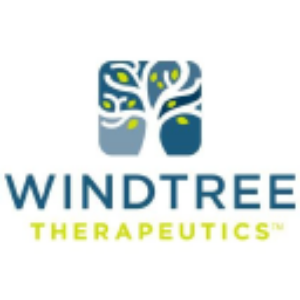Windtree Announces Publication of Istaroxime Positive Phase 2 SEISMiC B Study
Rhea-AI Summary
Positive
- Successfully met primary endpoint in Phase 2 SEISMiC B study with multiple positive outcomes
- Demonstrated unique beneficial effects including increased blood pressure, improved cardiac output, and preserved renal function
- Targeting $1.25 billion cardiogenic shock market with potential competitive advantages
- In discussions with multiple partners that could eliminate cardiovascular pipeline cash burn
- Completed four positive Phase 2 studies showing consistent results
Negative
- Phase 3 trials still pending and require significant funding
- Dependent on securing partnerships for further clinical development
- Final results of ongoing SEISMiC C trial not yet available
News Market Reaction 1 Alert
On the day this news was published, WINT gained 1.35%, reflecting a mild positive market reaction.
Data tracked by StockTitan Argus on the day of publication.
The Phase 2 Istaroxime study was successful in multiple endpoints showing promise for how it may be utilized if approved in its targeted indications
Primary endpoint of the study was met of increasing systolic blood pressure and demonstration of other benefits including no increase in heart rate and preserved renal function
Partnership discussions with multiple potential partners that may fund the remainder of clinical development thus eliminating the Company’s cash burn with the cardiovascular pipeline
Phase 2 SEISMiC C interim data results targeted for July
Final stages of protocol design for Phase 3 in acute heart failure indication for China nearly complete for regional license partner and will be fully funded by the licensee
WARRINGTON, Pa., June 16, 2025 (GLOBE NEWSWIRE) -- Windtree Therapeutics, Inc. (“Windtree” or the “Company”) (NasdaqCM: WINT), a diversified company focused on revenue generation in multiple growing industries, announced that the istaroxime early cardiogenic shock Phase 2 study called SEISMiC B is published in the Journal of Heart and Lung Transplantation and is available on the journal website. The publication is entitled “Safety and Efficacy Intravenous Istaroxime up to 60 hours for Patients with Pre-Cardiogenic Shock.1” Patients with this condition have poor cardiac function, low blood pressure and need rapid treatment.
The article notes in the SEISMiC B study that istaroxime significantly increased blood pressure over the first six hours of treatment and persisted for 60 hours. Patients also had significantly improved cardiac output, decreased pulmonary capillary wedge pressure (a measure of fluid back up), no increase in heart rate, no increase in clinically significant arrythmias and preserved renal function, a very unique profile of potential beneficial effects for this patient population.
An accompanying editorial highlighted the encouraging results and described istaroxime as, “a potential new approach to heart failure-cardiogenic shock in which the next frontier is not just survival, but earlier and smarter stabilization.2”
Istaroxime has completed four positive Phase 2 studies, including two in early cardiogenic shock (called SCAI Stage B). Market research conducted by the Company with U.S. based clinical cardiologists reveals a high desire for cardiogenic shock drug treatment innovation.
“We are having discussions with multiple potential partners for our cardiovascular pipeline,” said Jed Latkin, Chief Executive Officer of Windtree. “Removing this clinical development cash burn would be valuable to the Company. Additionally, the cardiogenic shock market value was
After successful SEISMiC A and B studies in Early Cardiogenic Shock, SEISMiC C will treat more severe SCAI Stage C cardiogenic shock to complete the assessment of the intended Phase 3 patient population. SCAI Stage C patients have progressed in their cardiogenic shock and heart failure to the point of tissue and vital organ hypoperfusion (lack of blood flow and oxygen) and typically require inotropic or vasopressor drugs for support. These drugs are used with caution due to deleterious side effects – many of which we believe istaroxime may potentially avoid based on results to date from four previous studies in acute heart failure and early cardiogenic shock. The Company intends to include SCAI Stage C patients as part of the Phase 3 patient population for cardiogenic shock.
About Istaroxime
Istaroxime is a first-in-class dual-mechanism therapy designed to improve both systolic and diastolic cardiac function. Istaroxime is a positive inotropic agent that increases myocardial contractility through inhibition of Na+/K+- ATPase with a complimentary mechanism that facilitates myocardial relaxation through activation of the SERCA2a calcium pump on the sarcoplasmic reticulum enhancing calcium reuptake from the cytoplasm. Data from multiple Phase 2 studies in patients with early cardiogenic shock or acute decompensated heart failure demonstrate that istaroxime infused intravenously significantly improves cardiac function and blood pressure without increasing heart rate or the incidence of clinically significant cardiac rhythm disturbances.
About Windtree Therapeutics, Inc.
Windtree Therapeutics, Inc. is a diversified company focused on becoming a revenue generating company in a multitude of growing industries to drive toward overall profitability.
Forward Looking Statements
The Company may, in some cases, use terms such as “predicts,” “believes,” “potential,” “proposed,” “continue,” “estimates,” “anticipates,” “expects,” “plans,” “intends,” “may,” “could,” “might,” “will,” “should” or other words that convey uncertainty of future events or outcomes to identify these forward-looking statements. Such statements are based on information available to the Company as of the date of this press release and are subject to numerous important factors, risks and uncertainties that may cause actual events or results to differ materially from the Company’s current expectations. Examples of such risks and uncertainties include, among other things: the ability of the Company to progress istaroxime toward Phase 3 readiness; the completion of the sale of the Company’s preclinical oncology aPKCi inhibitor platform; the Company’s ability to acquire revenue generating subsidiaries; the market’s reaction to potential acquisitions by the Company; the Company’s ability to secure significant additional capital as and when needed; the Company’s risks and uncertainties associated with the success and advancement of the clinical development programs for istaroxime and the Company’s other product candidates, including preclinical oncology candidates; the Company’s ability to access the debt or equity markets; the Company’s ability to manage costs and execute on its operational and budget plans; the results, cost and timing of the Company’s clinical development programs, including any delays to such clinical trials relating to enrollment or site initiation; risks related to technology transfers to contract manufacturers and manufacturing development activities; delays encountered by the Company, contract manufacturers or suppliers in manufacturing drug products, drug substances, and other materials on a timely basis and in sufficient amounts; risks relating to rigorous regulatory requirements, including that: (i) the U.S. Food and Drug Administration or other regulatory authorities may not agree with the Company on matters raised during regulatory reviews, may require significant additional activities, or may not accept or may withhold or delay consideration of applications, or may not approve or may limit approval of the Company’s product candidates, and (ii) changes in the national or international political and regulatory environment may make it more difficult to gain regulatory approvals and risks related to the Company’s efforts to maintain and protect the patents and licenses related to its product candidates; risks that the Company may never realize the value of its intangible assets and have to incur future impairment charges; risks related to the size and growth potential of the markets for the Company’s product candidates, and the Company’s ability to service those markets; the Company’s ability to develop sales and marketing capabilities, whether alone or with potential future collaborators; the rate and degree of market acceptance of the Company’s product candidates, if approved; the economic and social consequences of the COVID-19 pandemic and the impacts of political unrest, including as a result of geopolitical tension, including the conflict between Russia and Ukraine, the People’s Republic of China and the Republic of China (Taiwan), and the evolving events in the Middle East, and any sanctions, export controls or other restrictive actions that may be imposed by the United States and/or other countries which could have an adverse impact on the Company’s operations, including through disruption in supply chain or access to potential international clinical trial sites, and through disruption, instability and volatility in the global markets, which could have an adverse impact on the Company’s ability to access the capital markets. These and other risks are described in the Company’s periodic reports, including its Annual Report on Form 10-K, Quarterly Reports on Form 10-Q and Current Reports on Form 8-K, filed with or furnished to the Securities and Exchange Commission and available at www.sec.gov. Any forward-looking statements that the Company makes in this press release speak only as of the date of this press release. The Company assumes no obligation to update forward-looking statements whether as a result of new information, future events or otherwise, after the date of this press release.
1Biegus J, et al, J Heart Lung Transplant, (2025) https://doi.org/10.1016/j.healun.2025.05.013
2Ortega-Hernández JA, et al, J Heart Lung Transplant, (2025) doi:https://doi.org/10.1016/j.healun.2025.06.005
3Moin EE, et al, JAMA. 2025;333(20):1793-1803. doi:10.1001/jama.2025.2163
Contact Information:
Eric Curtis
ecurtis@windtreetx.com








